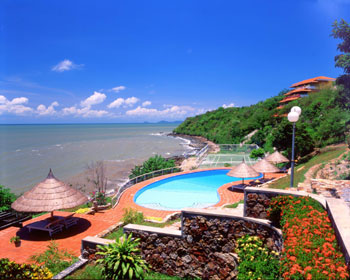“Oh my kids did have a wonderful time at Dam Sen Park, and keep asking me to bring them back some day!”, smiled a young mother when asked about Dam Sen park in Hochiminh City.
Most families visiting Hochiminh City much enjoy interesting games in Dam Sen Park, the ideal place of interest for small children. Opened in 1999, it now covers more than 50 ha on the corner of Lac Long Quan and Hoa Binh Street, and comprises various areas. Annually, it has several new water slides added.
Aquatic games and activities are much available here for all kinds of visitors. Water fountains, water pupetry, water games, truly unique water slide experiences (including the amazing "Space Bowl"), etc. attract thousands of turns of guests.
Ideal for kids. A series of water games for kids are of much interest. Also, a flower garden, a fun house, a ball game centre, electronic games, and so forth, are desired by every kid taking part in. Your kids will also feel the same, for sure!
Also geared for adults. Not only kids but also many adults are fond of the park. A very beautiful rose garden and a prehistoric valley are ideal for couples to walk and relax, make-up rooms are deeply useful for women. There is also an area for camping and a lake offering many aquatic activities. A pavilion for dancing and the water puppetry is located near the lake.
Actually, Dam Sen park is a large-scaled park within the city, which is particularly convenient for city dwellers to come and enjoy themselves here, especially at weekends. A whole complex including Co-op mart, a modern bowling center, luxurious Sports and Gymnasium Center, etc. will satisfy all kinds of your needs for shopping, entertainment and give you a truly relax holiday.

.jpg) Saigon is a relatively young Asian city, founded in the 18th century, but its history tells the story of Vietnam's recent struggles. Settled mainly by civil war forces fleed from north Vietnam along with Chinese merchants and refugees, Saigon quickly became a major commercial center in the late 1800s. With a very convenient protected port along the Saigon River, the city became a confluence in Indochina for goods passing from China and India to Europe. Places like today's popular tourist stop Ben Thanh Market were abuzz with activity. When the French took over the region about that time, in the 1880s, they called the south "Cochin China," Annam being central Vietnam and Tonkin is the north. Saigon became the capital. We owe the wide boulevards and grand colonial facades of central District 1 to years of French control and influence. After the French left in 1954, Saigon remained the capital of the Republic of Vietnam (South Vietnam) until national reunification in 1975.
Saigon is a relatively young Asian city, founded in the 18th century, but its history tells the story of Vietnam's recent struggles. Settled mainly by civil war forces fleed from north Vietnam along with Chinese merchants and refugees, Saigon quickly became a major commercial center in the late 1800s. With a very convenient protected port along the Saigon River, the city became a confluence in Indochina for goods passing from China and India to Europe. Places like today's popular tourist stop Ben Thanh Market were abuzz with activity. When the French took over the region about that time, in the 1880s, they called the south "Cochin China," Annam being central Vietnam and Tonkin is the north. Saigon became the capital. We owe the wide boulevards and grand colonial facades of central District 1 to years of French control and influence. After the French left in 1954, Saigon remained the capital of the Republic of Vietnam (South Vietnam) until national reunification in 1975.







 Unknown
Unknown

 Posted in:
Posted in: 


















